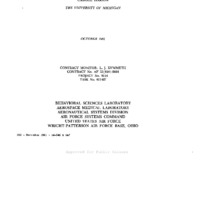-
Title
-
Flight Simulation of Orbital and Reentry Vehicles Part I - Development of Equations of Motion in Six Degrees of Freedom
-
Description
-
Equations governing the motion of a lifting reentry vehicle in six degrees of freedom are developed for simulation purposes. Effects of earth rotation, earth oblateness and wind velocity are included. The rotational equations are conventional equations involving angular rates referred to body axes. Two different formulations of the translational equations are presented, using different coordinate systems. One involves spherical coordinates referred to the equatorial plane of the rotating earth; the other involves spherical coordinates referred to a nominal trajectory plane fixed with respect to inertial axes. The former has the advantage that earth rotation and oblateness are taken into account more simply, but an indeterminacy is encountered in the event of flight over a pole. The latter formulation eliminates this indeterminacy but is otherwise more complex.
It is concluded that the equations developed are suitable for digital or hybrid analog-digital computation, but that accuracy requirements would be excessive for analog computation exclusively. An alternative formulation, suitable for analog computation, is presented in Part II of the present series.
-
Date
-
1961
-
Index Abstract
-
Contrails and DTIC
-
Photo Quality
-
Not Needed
-
Report Number
-
ASD TR 61-171 (I)
-
Corporate Author
-
University of Michigan
-
Laboratory
-
Behavioral Sciences Laboratory
-
Extent
-
41
-
Identifier
-
AD0269282
-
AD0269282
-
Access Rights
-
OTS
-
Distribution Classification
-
1
-
Contract
-
AF 33(616)-5644
-
DoD Project
-
6114
-
DoD Task
-
611407
-
DTIC Record Exists
-
Yes
-
Distribution Change Authority Correspondence
-
None
-
Abstract
-
Equations governing the motion of a lifting reentry vehicle in six degrees of freedom are developed for simulation purposes. Effects of earth rotation, earth oblateness and wind velocity are included. The rotational equations are conventional equations involving angular rates referred to body axes. Two different formulations of the translational equations are presented, using different coordinate systems. One involves spherical coordinates referred to the equatorial plane of the rotating earth; the other involves spherical coordinates referred to a nominal trajectory plane fixed with respect to inertial axes. The former has the advantage that earth rotation and oblateness are taken into account more simply, but an indeterminacy is encountered in the event of flight over a pole. The latter formulation eliminates this indeterminacy but is otherwise more complex.
It is concluded that the equations developed are suitable for digital or hybrid analog-digital computation, but that accuracy requirements would be excessive for analog computation exclusively. An alternative formulation, suitable for analog computation, is presented in Part II of the present series.
-
Report Availability
-
Full text available
-
Date Issued
-
1961-10
-
Provenance
-
RAF Centre of Aviation Medicine
-
Type
-
report
-
Format
-
1 online resource (viii, 33 pages) : ill.
-
Creator
-
Isakson, Gabriel
-
Subject
-
Flight Simulators
-
Reentry Vehicles
-
Artificial Satellites
-
Atmosphere Entry
-
Differential Equations
-
Dynamics
-
Equations
-
Flight Paths
-
Mathematical Analysis
-
Orbits
-
Pilots
-
Training Devices
-
Publisher
-
Wright-Patterson Air Force Base, OH : Behavioral Sciences Laboratory, Aerospace Medical Laboratory, Aeronautical Systems Division, Air Force Systems Command, United States Air Force
-
Distribution Conflict
-
No
 ASDTR61-171volume01.pdf
ASDTR61-171volume01.pdf